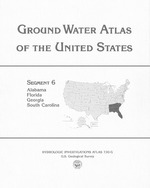Ground Water Atlas of the United States: Segment 6, Alabama, Florida, Georgia, South Carolina
Links
- More information: USGS Index Page (html)
- Document: Report (63.99 MB pdf)
- Larger Work: This publication is Chapter G of Ground Water Atlas of the United States
- Download citation as: RIS | Dublin Core
Abstract
The four States-Alabama, Florida, Georgia, and South Carolina-that comprise Segment 6 of this Atlas are located adjacent to the Atlantic Ocean or the Gulf of Mexico, or both. These States are drained by numerous rivers and streams, the largest being the Tombigbee, Alabama, Chattahoochee, Suwannee, St. Johns, Altamaha, and Savannah Rivers. These large rivers and their tributaries supply water to cities such as Columbia, S.C., Atlanta, Ga., and Birmingham, Ala. However, the majority of the population, particularly in the Coastal Plain which comprises more than one-half of the four-State area, depends on ground water as a source of water supply. The aquifers that contain the water are mostly composed of consolidated to unconsolidated sedimentary rocks, but also include hard, crystalline rocks in parts of three of the States. This chapter describes the geology and hydrology of each of the principal aquifers throughout the four-State area.
Precipitation is the source of all the water in the four States of Segment 6. Average annual precipitation (1951-80) ranges from about 48 inches per year over a large part of central South Carolina and Georgia to about 80 inches per year in mountainous areas of northeastern Georgia and western South Carolina. (fig. 1) In general, precipitation is greatest in the mountains (because of their orographic effect) and near the coast, where water vapor, which has been evaporated primarily from the ocean and the gulf, is picked up by prevailing winds and subsequently condenses and falls as precipitation when reaching the shoreline.
Much of the precipitation either flows directly into rivers and stream as overland runoff or indirectly as baseflow discharging from aquifers where the water has been stored for a short time. Accordingly, the areal distribution of average annual runoff from 1951 to 1980 (fig. 2) directly reflects that of average annual precipitation during the same period: runoff is greater in mountainous areas and near the coast. Average annual runoff in the four-State area ranges from about 8 inches per year in parts of north-central Florida to about 50 inches per year in the mountains of northeastern Georgia.
Comparison of the precipitation and runoff maps shows precipitation is greater than runoff everywhere in the four-State area. Much of the precipitation that falls on the area is returned to the atmosphere by evapotranspiration-evaporation from surface-water bodies, such as lakes and marshes, and transpiration from plants. However, a substantial part of the precipitation is available for aquifer recharge throughout the area.
Study Area
| Publication type | Report |
|---|---|
| Publication Subtype | USGS Numbered Series |
| Title | Ground Water Atlas of the United States: Segment 6, Alabama, Florida, Georgia, South Carolina |
| Series title | Hydrologic Atlas |
| Series number | 730 |
| Chapter | G |
| ISBN | 0607767561 |
| DOI | 10.3133/ha730G |
| Year Published | 1990 |
| Language | English |
| Publisher | U.S. Geological Survey |
| Contributing office(s) | South Atlantic Water Science Center |
| Description | 28 p. |
| Larger Work Title | Ground Water Atlas of the United States |
| Country | United States |
| State | Alabama, Florida, Georgia, South Carolina |


